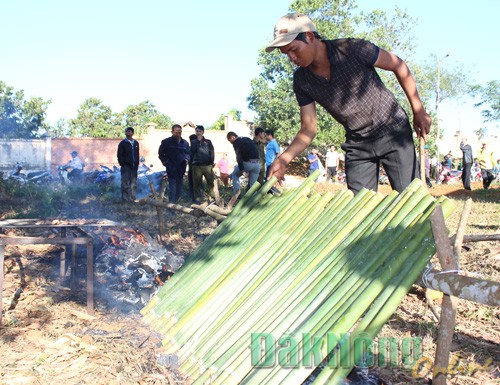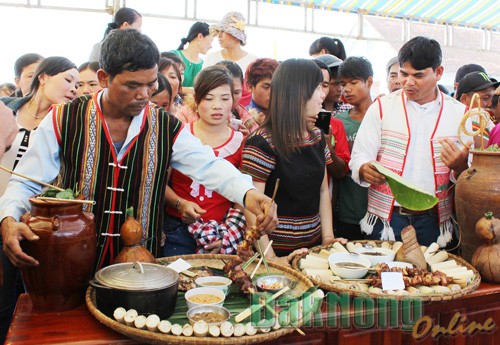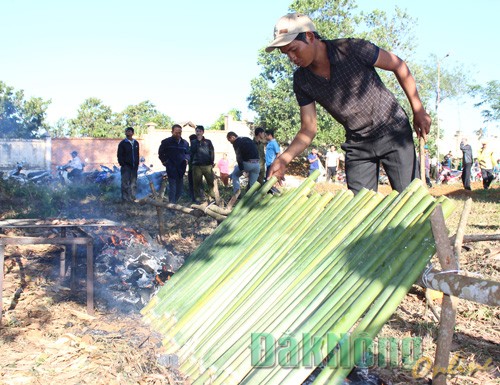
In the old days, Vietnamese ethnic minority people in general and Ma people (an ethnic group in Vietnam) in particular had the practice of shifting cultivation and living in the milpa. That's why they often create urdimentary instruments and make use of forestry material to make food. Com Lam (the rice cooked in a bamboo cylinder) also had its origin from this process.
To make Com Lam, sticky rice is put into the bamboo cylinder and cooked through using water taken from spring or cliffs. This way of cooking rice is extremely unique, because the rice is cooked inside a closed tight bamboo cylinder, consequently, its smell is kept intact and the nutrition is preserved. For Ma people in Dak Nong province, Com Lam is a popular food item and considered indispensable during holidays and festivals
  |
| Com Lam and roasted meat is a familiar combination in the meal of Ma people. |
Making soft and good-smelled Com Lam requires meticulousness and cleverness in such steps as: selecting rice, preparing bamboo cylinder and placing it over the burning charcoal... Sticky rice selected to make Com Lam must be the kind that has medium-sized, smooth, long, white and good-smelled seeds. It is then steeped in water for hours or overnight. After that, the rice is washed clean, mixed with a little of salt and put into bamboo cylinder.
The bamboo cylinder must not be too young or too old, with the length of about 1 metre. When filling the rice, it should not be stuffed too tight into the bamboo cylinder. Next, kinds of leaves taken from forest can be used to stop the end of the bamboo cylinder. Usually, Ma people use the leaves of wild pineaple tree to stop the end of the bamboo cylinder which would create a special smell for Com Lam over cooking process.
Before cooking, the charcoal must be prepared and burned very well to make sure the rice was thoroughly cooked and not get dry. The rice-filled bamboo cylinder must not be place directly on the burning charcoal; instead, it must have one end touching the land and the other end rested on a horizontal bar to make an octant. The rice-filled bamboo cylinder must be turned regularly until the whole bamboo cylinder get dried from theexterior. When the smell of the rice is released from the end of the rice-filled cylinder, that's when the rice is done enough. One thing to pay attention is that when the rice was close to being cooked through, it is necessary to make a hole under the bamboo cylinder to avoid the steam inside getting too much and broking the bamboo cylinder, which would make the rice not delicious.
Com lam is cut into chunks to make it easy to eat and able to keep the thin and white peel layer inside the bamboo cylinder intack and sticked to the rice that is soft, steaming hot and reeks of sweet smell from forestry leaves. A little of sesamed or chillied salt brought along with some chunks of Com Lam of 10 - 15 cm long inside the back basket could make a solid and full meal for people to go and work in the milpa. The remarkable feature of Com Lam is that it can be kept for quite a long time, even to the next day without going off and getting spoilt.
  |
| Ma people made Com Lam in a holiday of the village |
From the time when the seeds of rice were sown till the time of harvest, and the time Com Lam was made, Ma people have considered the food as the quintessence of the combination of earth, heaven, mountain, forest and deities's favour. It is also the harmony featuring the principle of Yin and Yang with 5 basic elements of the universe (including Metal, Wood, Water, Fire, and Earth). The bamboo cylinder used to cook rice features wood element; water used to cook is taken from spring, waterfall represents water element, the fire used to cook represents fire element, the cooking process carried out on the land, in the forest features the Earth element…
With people's creativeness, this popular food bear a deep spirit significance. During the time of festivals, if there was roasted meat, it would be necessarily eaten with Com lam. Among the food items to make offering for the deities of Ma people, the white rice together with brown yellowish roasted meat becomes a very unique combination. It would be very interesting to enjoy the pungent taste of Ruou can (wine drunk out of jar through pipes) together with soft and sweet Com Lam, feel the charming and greasy taste of roasted meat and listen to Ma people telling stories about their ancestors' reclaiming virgin soil in the mountain areas and set up villages in the lengendary basalt land.
According to baodaknong.org.vn
Weather
| Đắk Nông | |
| Pleiku | |
| TP Hồ Chí Minh | |